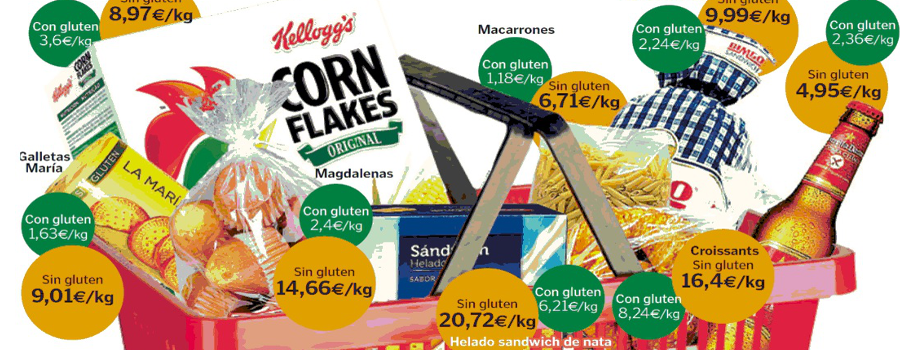Celiac disease is a condition developed by people who are intolerant to gluten and is characterized by an inflammatory reaction, where the immune system mistakenly attacks the intestine as if it were an external aggressor and causes lesions in the mucous affecting nutrients and vitamin absorption. This disease can affect both sexes by equally and can start at any time, from infancy (as soon as cereal grains are introduced into the diet) to adulthood (even when individuals have consumed cereal grains all his life).
The most common symptoms are weight loss, fatigue, nausea, vomiting, diarrhea, stunted growth, anemia, abdominal pain, among others. Although sometimes is more complicated because there are people who do not show any of these symptoms or they may be so atypical that the diagnosis is difficult. This condition is detected by clinical examination, an analytical measuring specific antibodies (transglutaminase and immunoglobulin A) generated in the intestine and an intestinal biopsy that allows a reliable diagnosis.

But what exactly is gluten? The cause of this disease is a set of proteins contained in cereals such as wheat, barley, rye and oats, and products derived from them (white flour, white wheat, graham flour, Triticum, wheat, kamut, spelled, germ wheat, wheat bran, etc.). According to Molina-Rosell, gluten serves to give elasticity to the masses, allowing the products have volume and an elastic and fluffy. So far, the part that almost all know. But what not everyone knows is that it is also used as an additive to give viscosity, thickness or volume to a lot of foods such as sausage (chopped, mortadella, sausage, black pudding, etc.), pates, cheeses, preserved by meat and fish, sauces, coffee substitutes, chocolat and cocoa, roasted or fried nuts with flour and salt, candy, snacks and some ice cream. In resume, a celiac has it really hard to have a varied diet safely.
Fortunately, there are some solutions for not including gluten in many foods. In the case of cereals, they are replaced wheat, barley, rye and oats with corn, rice, millet, quinoa, etc. With this, celiac could safely consume bread, flour, pasta and biscuits. The problem comes when we realize that the price of these products gluten free can be up to 448% higher than foods with gluten! A very simple example, according to 2015 Prices Report: normal bread costs € 2.11 / kg. Gluten-free bread € 9.48 / kg.
The next question is why? The answer is that the process of preparing food without gluten is considerably more complicated. Without the natural “glue” that gluten produces, the masses are liquid and cannot be baked. For this reason is necessary to use other products that help to simulate the characteristics provided by the gluten. Then the hydrocolloids (locust bean gum, guar gum, xanthan gum, agar, pectins and β-glucans), emulsifiers, enzymes or proteins, starch, combined with fats and dairy derivatives are chosen to impart viscoelastic properties.
But, besides in the process of developing gluten free food, should be used exclusively equipment and utensils, or have been properly cleaned previously. Cannot use oils or fryers where previously fried foods that have gluten, nor can use trays that previously contained gluten products. According to the Guide to prepare menus without gluten, throughout the production process should prevent cross-contamination with gluten products because, for a food to be considered gluten free, must comply with the legislation (Regulation 41/2009) and contain less than 20 mg of gluten per kilogram of product.
Quite a challenge for food R&D, which is already working on new processes and systems that can streamline production and achieve a significant decline in the price of gluten free food.
- Millenary food: superfoods - 22 April 2016
- Gluten-free diet: Is it a new way to lose weight? - 11 March 2016
- How much expensive is to be a celiac in Spain? - 29 January 2016
